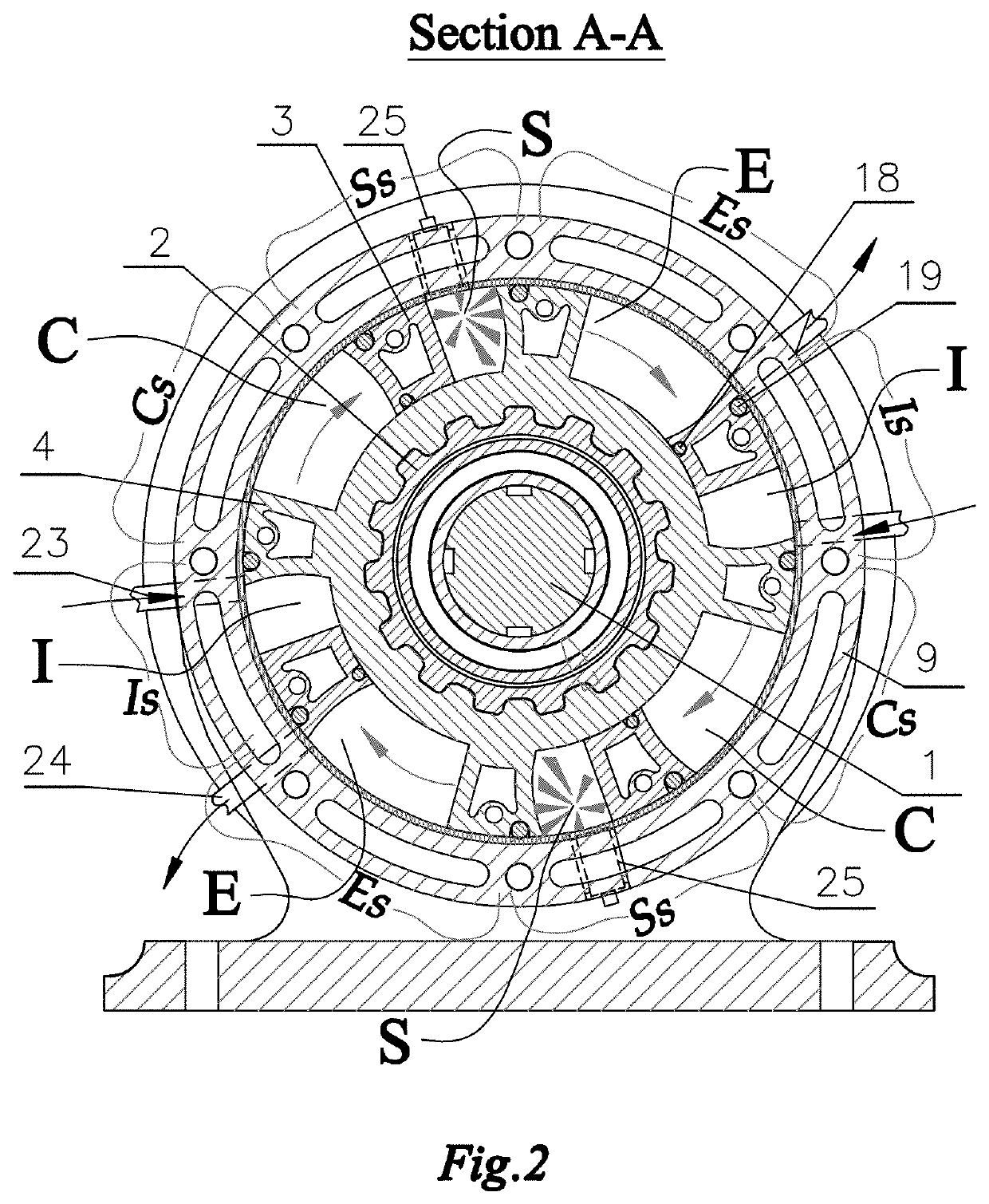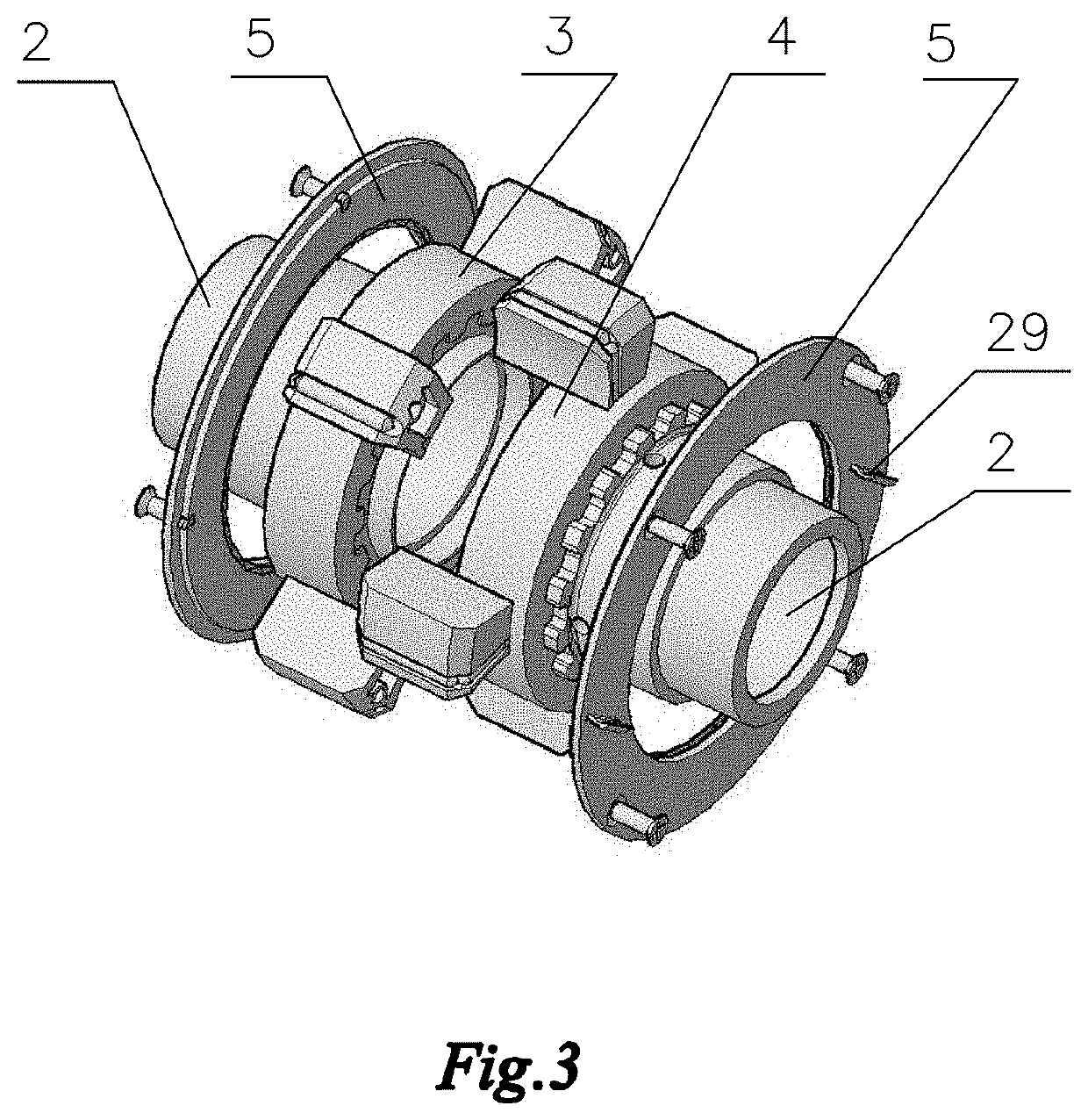Current designs of rotary vane internal
combustion engines have serious disadvantages: complicated mechanisms for coordinating movement of the rotors (vanes), increased temperature and wear of surfaces due to friction, availability of reciprocation of working elements.
However, such a
rotary machine described a mechanism for converting the movement of vanes still has large dimensions.
Not eliminated the alternating shock loads because do not provide guaranteed gap acceleration and deceleration of working motors.
Disadvantages of this
rotary machine and this type of rotary engines are related to difficulties removing the power from two different shafts, each connected to its communication mechanism with vanes that move irregularly and impulsively.
Removing power from such shafts of the proposed method is extremely difficult.
The required approval of their motion relative to each other is performed using extremely complex and cumbersome mechanism for synchronization.
The huge inertial loadings destroy the applied mechanisms of coordination of rotation shafts and related rotor vanes.
And serious problem of the engine is the seal of clearances and fabrication of working surfaces of the rotor vanes.
A problem with some prior art rotary vane machines is that they cannot successfully operate under
high pressure and heat.
This creates an inability to operate under
high pressure and heat due to poor seals on the vanes and
high torque on the vanes.
In addition, the vanes have a return-translational movement that aggravates the operation of the mechanism and at high temperatures will jam.
Intake, exhaust, and ignition systems provide a combustion cycle for each chamber as the rotor orbits and cannot be cooled and cannot readily be lubricated so is very susceptible to overheating, which keeps it from being
usable, and can't eliminate the reciprocating movement of the vanes.
Because the engine cannot be cooled and cannot readily to be lubricated, it is very susceptible to overheating.
This keeps it from being
usable and can't eliminate the reciprocating movement of the vanes.
The vanes working under load having the reciprocating movement, however, cannot be cooled and cannot readily to be lubricated, so are very susceptible to overheating, which prevents the engine from being
usable.
The rotor and vanes cooperate with the housing to define a plurality of chambers which become successively smaller as they are charged with fuel and approach the firing area of the housing, and larger after combustion as they approach the exhaust and intake segments of the housing, cannot be cooled and cannot readily to be lubricated so are very susceptible to overheating, and prevents it from being usable.
Rotors at the same time, have a complex movement and conditions and can't be cooled and can't readily to be lubricated, so they are very susceptible to overheating, which prevents the engine from being usable.
Disadvantage is that the vanes slide within the slotted guides and are necessary to maintained in constant alignment therewith by an arm coupled to each of the guides and to the rotor shaft, which is an important negative feature as the vanes of the power rotor leave, at some point during the operation of the engine, their respective slotted guides can be destroyed.
When the charge of the combustible mixture ignited it is practically difficult to coordinate the radial movement of the blade with the
cam, where the rotational and translational movements must coincide
The big
disadvantage is that the output shaft of forced
porting mechanism forcing orchestrating the synchronized operations of the
fuel injection and spark ignition systems.
However, it is a very complex rotor with many grooves, with each slot supporting a void.
The rotor and a plurality of vane-
piston assemblies that are located in a
radiation arrangement on the rotor have a translational and rotational movement, which greatly complicate and renders the whole process unreliable.
The above-listed prior art includes the following disadvantages:The presence of reciprocating movement of the working elements;The use of complex and unreliable mechanisms to synchronize movement between the vanes;Lack of cooling of the working area of the engine;Lack of the possibility of intensive
lubrication of working surfaces.
 Login to View More
Login to View More  Login to View More
Login to View More 


